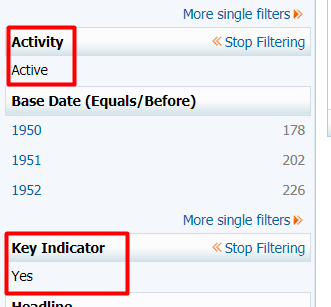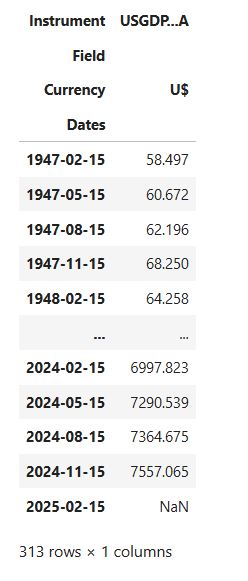
Updated: 07 Mar 2025
An economic indicator is a statistic matric of an economic activity used by investors to evaluate the overall health of an economy and predict future investment possibilities. Economic indicators are typically surveyed or gathered by a government department or private organization. Economic indicators cover many things including the unemployment rate, inflation rate, gross domestic product, population, bankruptcies, etc.
This article demonstrates how to use Datastream to access cross-countries' economic indicators.
Datastream
Datastream is the world’s leading time-series database, enabling strategists, economists, and research communities’ access to the most comprehensive financial information available. With histories back to the 1950s, you can explore relationships between data series; perform correlation analysis, test investment and trading ideas, and research countries, regions, and industries.
The Datastream database has over 35 million individual instruments or indicators across major asset classes. You can directly invoke the web service methods from your own applications by using metadata information we publish.
The Datastream Web Service allows direct access to historical financial time series content listed below.
For more information, please refer to Datastream Web Service.
Example
In this section, I will walk through a DataStream Web Service example used to retrieve economic indicators by countries. The example uses the DatastreamPy library to connect and retrieve data from Datastream. To use this Python library, please refer to the Getting Started with Python document.
Loading Libraries
The required packages for this example are:
- DataStreamPy: Python API package for LSEG Datastream Webservice
- pandas: Powerful data structures for data analysis, time series, and statistics
- ipywidgets: IPython HTML widgets for Jupyter
- IPython.display: Public API for display tools in IPython
- plotly: An open-source, interactive data visualization library for Python
You also need to install lxml package (pip install lxml) used by pandas when parsing the HTML file.
import DatastreamPy as DSWS
import pandas as pd
import ipywidgets as widgets #IPython widgets
from ipywidgets import Button, HBox, VBox, Layout, Dropdown, Label
from IPython.display import display, clear_output
import plotly.express as px
Setting Credentials
The DataStream username and password are required to run the example.
ds = DSWS.DataClient(None, username = 'username', password = 'password')
Loading an Instrument List
In Datastream, the economic indicators are available under the Economics category. The data can be filtered by countries.
A table on the right displays all economic data available in Datastream.
In this example, we only focus on active key indicators so we add two filters (Activity and Key Indicator) to refine the search result.
From the search results, there are around 8,600 active key indicators.
After that, the search results can be downloaded to an excel file (ActiveKeyIndicators.xls). This excel file can be read into a data frame object by calling the pandas.read_html method. In the data frame:
- The Name column contains short indicator names
- The Symbol column contains instrument names used by Datastream to retrieve data
- The Market column contains country names
- The Full Name column contains full indicator names
- The Frequency column contains the frequency of the time-series data
df = pd.read_html('ActiveKeyIndicators.xls')
df[0][["Name","Symbol","Market","Full Name","Frequency"]]
Economic Indicators By Countries
In this section, we will create a widget that allows users to display available economic indicators by selecting a country. First, it sets the display.max_rows option to 200 to increase the maximum number of rows and columns displayed by the data frame.
The widget displays a list of countries including the number of indicators in the dropdown list. After selecting a country, the economic indicators in that country are displayed.
pd.set_option('display.max_rows', 200)
class ListAllECIByCountryWidget:
status_label = Label("")
title_label = Label(value='')
linebreak_label = Label('')
button = Button(description='Select')
output = widgets.Output()
def __init__(self, _context):
country_count = _context.groupby(["Market"])["Symbol"].count()
self.country_dropdown = Dropdown(options=[(index+" ("+str(value)+")", index) for index, value in country_count.items()], value='United States', description='Country:')
display(HBox([self.country_dropdown,self.button]),
self.output)
self.button.on_click(self.on_button_clicked)
self._context = _context
def on_button_clicked(self,c):
with self.output:
self.output.clear_output() #clear and update output
self.title_label.value = r'\(\underline{\textbf{%s}}\)'%(self.country_dropdown.value)
display(VBox([ HBox([self.linebreak_label]),
HBox([self.title_label])
]))
display(self._context[self._context["Market"]==self.country_dropdown.value].set_index('Symbol')[["Name","Start Date","End Date","Frequency","Source","Full Name"]])
ListAllECIByCountryWidget(df[0])
Historical Economic Indicators By Countries
In this section, we will create a widget that displays historical data of a selected economic indicator. First, users need to select a country. Then, the widget creates a dropdown list containing economic indicators available in the selected country.
After selecting the economic indicator, the widget calls the get_data method in the DataStreamPy library to retrieve the unit of the historical data.
ds.get_data(tickers=symbol, fields=["ESUNT"],kind=0)
The symbol represents the Datastream symbol of the selected economic indicator. The ESUNT data type gives the unit quotation of the series. For example, the unit quotation of the United States Gross Domestic Product (USGDP...A) is USD BIL.
Next, the widget calls the get_data method again to retrieve the historical data.
ds.get_data(tickers=symbol, start='BDATE',freq=freq)
The BDATE is the base date representing the date from which Datastream holds information about the issue. The freq parameter is the frequency of historical data. It could be D (Daily), W (Weekly), M (Monthly), Q (Quarterly), and Y (Annual). The widget gets the frequency of the selected economic indicator from the Frequency column in the data frame. For example, the quarterly historical data of United States Gross Domestic Product (USGDP...A) since BDATE (1 Jan 1950) is shown below.
Finally, the widget calls the iplot method to plot a chart.
class HistoricalECIWidget:
status_label = Label("")
eci_dropdown = Dropdown()
eci_dropdown.description = "Economic:"
status_label = Label("")
title_label = Label(value='')
linebreak_label = Label('')
button = Button(description='Select')
output = widgets.Output()
def __init__(self, _context):
country_count = _context.groupby(["Market"])["Symbol"].count()
self.country_dropdown = Dropdown(options=[(index+" ("+str(value)+")", index) for index, value in country_count.items()], value='United States', description='Country:')
display(HBox([self.country_dropdown]),
HBox([self.eci_dropdown,self.button]),
self.title_label,
self.status_label,
self.output)
self.button.on_click(self.on_button_clicked)
self._context = _context.set_index("Symbol")
tuple_list = self._context[self._context["Market"]==self.country_dropdown.value].sort_values(by=['Name'])[["Full Name"]].to_records(index=True).tolist()
self.eci_dropdown.options = [t[::-1] for t in tuple_list]
self.country_dropdown.observe(self.on_country_change)
def _get_frequency(self, freq):
switcher={
'Daily':'D',
'Weekly':'W',
'Monthly':'M',
'Quarterly': 'Q',
'Annual': 'Y'
}
if freq in switcher:
return switcher[freq]
else:
return None
def on_button_clicked(self,c):
with self.output:
self.output.clear_output()
symbol = self.eci_dropdown.value
title = self._context.loc[symbol,"Full Name"]
self.title_label.value = r'\(\underline{\textbf{%s}}\)'%(title)
temp_unit = ds.get_data(tickers=symbol, fields=["ESUNT"],kind=0)
unit = temp_unit.iloc[0,2]
freq = self._get_frequency(self._context.loc[symbol,"Frequency"])
if freq==None:
self.status_label.value = "Unable to match a frequence: " + self._context.loc[symbol,"Frequency"]
return
display(self._context.loc[[symbol],["Name","Start Date","End Date","Frequency","Source"]])
df_data = ds.get_data(tickers=symbol, start='BDATE',freq=freq)
fig = px.line(x=df_data.index.tolist(), y=df_data[df_data.columns[0]].tolist(), title=title)
fig.update_yaxes(title_text=unit)
fig.update_xaxes(title_text=self._context.loc[symbol,"Name"]+" ("+self._context.loc[symbol,"Frequency"]+")")
display(fig)
def on_country_change(self, change):
with self.output:
self.eci_dropdown.options = []
tuple_list = self._context[self._context["Market"]==self.country_dropdown.value].sort_values(by=['Full Name'])[["Full Name"]].to_records(index=True).tolist()
self.eci_dropdown.options = [t[::-1] for t in tuple_list]
HistoricalECIWidget(df[0])
Summary
This article demonstrates how to use the Datastream Web Service to retrieve historical economic indicators for each country. First, it gets a list of key economic indicators from the Datastream website and loads the list to the data frame. Then, it creates two widgets. The first widget allows a user to choose a country and then it displays a list of economic indicators available in that country. The second widget allows a user to pick an economic indicator, then it displays a historical chart of the selected economic indicator.
References
- Developers.lseg.com. n.d. Datastream Web Service | LSEG Developers. [online] Available at: <https://developers.lseg.com/en/api-catalog/eikon/datastream-web-service> [Accessed 07 March 2025].
- En.wikipedia.org. n.d. Economic Indicator. [online] Available at: <https://en.wikipedia.org/wiki/Economic_indicator> [Accessed 30 October 2020].
- Corporate Finance Institute. n.d. Economic Indicators - Learn More About GDP, PMI, and CPI. [online] Available at: <https://corporatefinanceinstitute.com/resources/knowledge/economics/economic-indicators/> [Accessed 30 October 2020].
Request Free Trial
Call your local sales team
Americas
All countries (toll free): +1 800 427 7570
Brazil: +55 11 47009629
Argentina: +54 11 53546700
Chile: +56 2 24838932
Mexico: +52 55 80005740
Colombia: +57 1 4419404
Europe, Middle East, Africa
Europe: +442045302020
Africa: +27 11 775 3188
Middle East & North Africa: 800035704182
Asia Pacific (Sub-Regional)
Australia & Pacific Islands: +612 8066 2494
China mainland: +86 10 6627 1095
Hong Kong & Macau: +852 3077 5499
India, Bangladesh, Nepal, Maldives & Sri Lanka:
+91 22 6180 7525
Indonesia: +622150960350
Japan: +813 6743 6515
Korea: +822 3478 4303
Malaysia & Brunei: +603 7 724 0502
New Zealand: +64 9913 6203
Philippines: 180 089 094 050 (Globe) or
180 014 410 639 (PLDT)
Singapore and all non-listed ASEAN Countries:
+65 6415 5484
Taiwan: +886 2 7734 4677
Thailand & Laos: +662 844 9576









